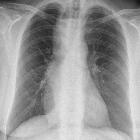Esophagus

The esophagus is a muscular tube that conveys food and fluids from the pharynx to the stomach.
Gross anatomy
The esophagus is 23-37 cm long with a diameter of 1-2 cm and is divided into three parts:
- cervical: continuous with the hypopharynx, commences at the lower border of cricoid cartilage (at level of C5/6) or cricopharyngeus muscle
- thoracic: from superior thoracic aperture (T1) to the esophageal hiatus (T10) in the diaphragm which covers the inferior thoracic aperture
- abdominal: from esophageal hiatus and is continuous with the cardia of the stomach at the gastro-esophageal junction
The cervical esophagus begins at the upper esophageal sphincter, which is formed by the cricopharyngeus muscle .
The esophagus then descends to the left of the midline through the neck and superior mediastinum, returning to the midline at T5, before coursing to the left of the midline once more, in the posterior mediastinum. The distal thoracic esophagus then curves anteriorly to pass through the diaphragm into the abdominal cavity.
The lower esophageal sphincter, also known as the phrenic ampulla or the esophageal vestibule, represents a 2-4 cm long dilatation between the A-ring and B-ring .
There are three normal esophageal constrictions that should not be confused for pathological constrictions:
- cervical constriction: due to cricoid cartilage at the level of C5/6
- thoracic constriction: due to aortic arch at the level of T4/5
- abdominal constriction: at esophageal hiatus at T10/11
Relations
- posteriorly: vertebral column; descending aorta; thoracic duct (at thoracic plane); accessory hemiazygos and hemiazygos veins (at T8/9)
- anteriorly: trachea (to T4/5); recurrent laryngeal nerves (in tracheo-esophageal groove); left main bronchus; left atrium
- left lateral: lung; pleura; aorta; left subclavian artery; thoracic duct
- right lateral: lung; pleura; azygos vein
Arterial supply
- upper third: inferior thyroid artery
- middle third: esophageal branches of the thoracic aorta
- lower third: esophageal branches of the left gastric artery
Venous drainage
- upper third: inferior thyroid veins to brachiocephalic veins
- middle third: azygos vein to SVC
- lower third: left gastric vein to portal vein (site of portal-systemic collateral pathway)
Lymphatic drainage
Follows arterial supply:
- upper third: deep cervical lymph nodes
- middle third: posterior mediastinal lymph nodes
- lower third: left gastric and celiac group lymph nodes
Innervation
- sympathetic trunk (sympathetic fibers)
- vagal plexus (parasympathetic fibers)
Histology
The esophagus is made up of five layers noting there is no serosal layer:
- outer longitudinal muscularis propria
- inner circular muscularis propria (in the upper 1/3 of the esophagus this layer is composed of striated (voluntary) muscle while the lower 2/3 is smooth muscle)
- submucosa
- muscularis mucosae
- mucosa
- stratified squamous epithelium that abruptly changes to columnar epithelium in the lower esophagus
Variant anatomy
- esophageal bronchus
- esophageal atresia
- aberrant right subclavian artery passing anterior or posterior to the esophagus
Radiographic appearance
Barium swallow
- modified barium swallow used to evaluate pharyngeal motility during swallowing, the procedure utilizes barium of varying consistencies given by mouth with video recording of swallowing
- barium swallow is the main radiological method of assessing the esophagus. Double contrast esophagogram using gas-forming crystals and barium contrast are used to distend the esophagus and coat the mucosa.
Endoscopic ultrasonography
Endoscopic ultrasonography is used for evaluation of the depth of the esophageal tumor.
CT
- 80% will contain gas allowing for appreciation of wall if there is enough surrounding mediastinal fat
- if collapsed will appear as round or ovoid
MRI
- T1: isointense to muscle
- T2: hyperintense to muscle
PET/CT
Useful for the staging of esophageal cancer.
Related pathology
- esophageal cancer
- benign esophageal neoplasms
- hiatus hernia
- achalasia
- GERD
- esophageal rupture
- esophageal stricture
Siehe auch:

 Assoziationen und Differentialdiagnosen zu Ösophagus:
Assoziationen und Differentialdiagnosen zu Ösophagus:






